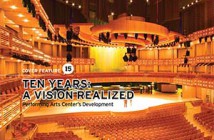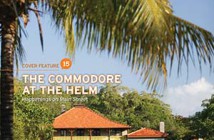Just outside the city limits of South Miami is a property that is distinguished for its significant contribution to American history, its association with a person significant to America’s past, and its distinctive characteristics and high artistic values. That property is the historic site of the Arden Hayes “Doc” Thomas (1887-1975) residence. Thomas established a life estate that gifted the land to the Tropical Audubon Society.
Arden Hayes Thomas Arrives in Dade County
Arden Thomas moved to Dade County from southern Indiana in the 1920s. Thomas operated the successful O.K. Drugstore (and the O.K. Feed Store) originally located on the north side of Sunset Drive in South Miami. He was a key businessman and active in the social scene of the young City of South Miami. Thanks to his pharmacology degree, Thomas also served as the local doctor, hence the nickname “Doc.”
He opened his pharmacy on the first floor of a small apartment building on Sunset Drive, just before the arrival of the devastating September hurricane in 1926. Even though several businesses folded as a result of the hurricane, including the shoe shop next door to his pharmacy, Thomas decided to take over that adjacent retail space and establish a feed store. Later, when US-1 was paved, he moved his stores there to take advantage of the increased flow of traffic (near today’s Swensen’s).
The House is Built In time, Thomas purchased 16 contiguous lots in High Pines, siting his 1,775 sq. ft. cottage just east of Red Road on three acres of a densely-vegetated pine and hardwood hammock. Thomas lived here with his mother Margaret until her death and then alone until his death in 1975. The Thomas family planted native and exotic trees and shrubs around the property and had chickees and a corral for Doc’s horses constructed behind the cottage. He may have had three to four chickees on the property purportedly built for him by Miccosukee Chief Tiger Tiger. One original chickee remains and was recently renovated by the Tropical Audubon Society.
Located at 5530 Sunset Drive, the residence was designed by the architect Robert Fitch Smith and built in 1932 (cost: $4,500). Smith, who later became the first chairman of the Department of Architecture at the University of Miami, designed a home that would complement the existing native landscape.
Constructed of tidewater cypress with oak, walnut, mahogany and Dade County pine interiors, the Rustic style one-story, side-gabled building is remarkable for its exterior cladding, full-width screened front porch, and chimney made from local stone. The detailed woodwork is a one of the most distinctive features of the house. The front of the house sports vertical board and batten siding, and the wood cornices are laid out with dentils in a zig-zag pattern. There are two wings extending from the rear of the house that create a U-shape within which a patio was laid.
Inside is the living room with fireplace, window seat and warm wood flooring. Three bedrooms, bath and storage are on the east side, and a breakfast nook and kitchen are to the west. The living room’s window seat overlooks the patio.
The living room flooring has random-width oak boards pegged with mahogany and separated by walnut strips. The floors in the bedrooms, breakfast nook and kitchen are made from Dade County pine. The fireplace, located at the west wall of the residence repeats the same use of local limestone as the exterior. Limestone from Matacumbe Key (Keystone) contains the fossilized remains of marine creatures, and the porous, non-organic oolite is from Dade County.
The front porch and the living room dominate the plan. The residence is oriented north toward Sunset Drive. A shed roof covers the front porch and is supported by a coral rock foundation. A frieze over the front door features another zig-zag pattern in wood. The main entrance to the house is through the porch. The exterior of the front porch is clad in vertical cypress board and batten which then change to horizontal siding to match the rest of the house. The charming applied-wooden ornamentation found around the rest of the house is repeated on the porch.
The Historic Designation Report prepared for the National Trust by historic preservationists Kathleen Slesnick Kauffman, Sarah K. Cody and Carl Shiver says of the living room: “The living room serves as the primary interior space…The character-defining custom woodwork is evident throughout the living room. Exposed wood beams and brackets span the width of the room. Built-in features with simple wood ornamentation, such as a long window seat and a comer bench, add to the functionality of the space. A scalloped window molding frames the elongated window at the rear of the room. Here Doc Thomas and his mother could relax in the window seat that overlooks the back patio. Board and batten vertical paneling of Dade County pine mimics the exterior siding…The coral and limestone chimney stands at the west end of the living room, bringing a visually dominant exterior element into the main living space.”
The site was entered into the National Register on June 13, 2014.
Architect of Renown
Robert Fitch Smith (1894 – 1964) was born in Ohio and educated at the University of Michigan, the Carnegie Institute of Technology, the Western State College-Michigan, Columbia University and the University of Miami. He was an instructor of architectural design at the University of Miami from 1928 to 1931. He later became the first University of Miami Dean of Architecture. In 30 years, Smith designed over 600 residences and 200 civic, commercial and industrial buildings in South Florida and the Caribbean. Smith was a nationally-recognized architect who served on important local and national architectural boards.
Smith’s choice of the Rustic style for Doc Thomas’ house complements the native landscape on which the residence was constructed. Soon after it was built, the house was recognized for its charming and precise detailing and “understated” color palette. It was on the cover of The Lumberman’s Journal in June 1932 and the House & Garden Building Bulletin in 1936.
The Designation Report also speaks of the land on which the house stands as a contributing factor to the historic importance of the site. Doc Thomas was keen to maintain the natural pine rockland and tropical hardwood hammock that surrounded his home. Two features also contribute to the historic character of the site: the chickee and the remains of a native stone wall.
Preserving the Past
One year before his death, Thomas donated the house and grounds to the Tropical Audubon Society with the restriction that, “ It be preserved as a natural historic beauty spot so that future generations may observe a sample of the original terrain, flora, avifauna and forest of Early Dade County.”
With that charge from Thomas, the Tropical Audubon Society has kept his home in excellent condition; most recently re-roofing the structure and updating the electrical system. The house serves as both the Tropical Audubon Society headquarters and as a historic site (also designated by the County) visited and enjoyed by the public. This beautifully designed home, built with fine materials can best be described as a frame vernacular cottage in the Rustic style.
Executive Director of Tropical Audubon Society Laura Reynolds said, “The Doc Thomas House is perfectly situated in the South Miami Community to serve as a location to educate the public on environmental issues, engage citizens in helping to improve our quality of life through planting natives, attracting wildlife and restoring and connecting greenspace.”
The Tropical Audubon Society intends to maintain the house and to continue the restoration of the grounds so that the wishes of Doc Thomas will be fulfilled. The Tropical Audubon Society is located at 5530 Sunset Drive, Miami, Florida. For more information call, (305) 667-7337, or visit online at .
Note: The author wishes to recognize and thank historic preservationists Kathleen Slesnick Kauffman, Sarah K. Cody and Carl Shiver for their outstanding research regarding the Historic Designation Report for the Doc Thomas house.



